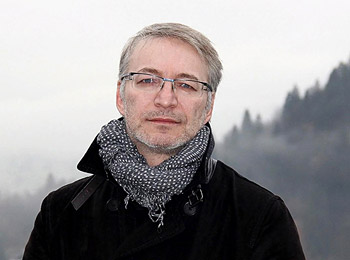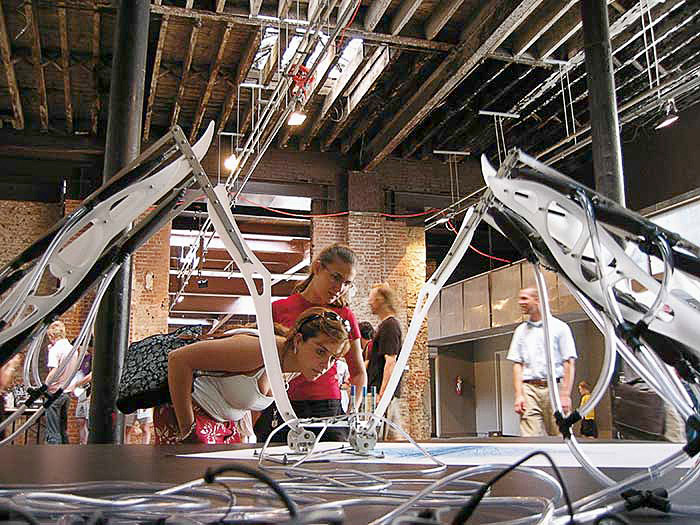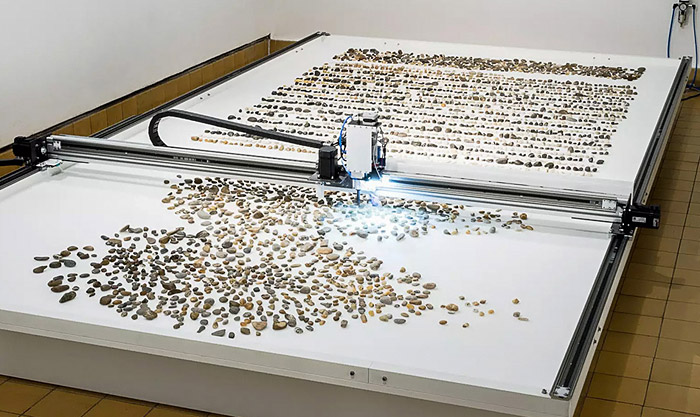
Electronic english version since 2022 |
The newspaper was founded in November 1957
| |
JINR Scientists' Club lecture hall
Union of art, science and technology
Emotional opinions, a sea of questions and a discussion with the speaker were the reactions to the lecture "Art&Science. Art on the edge of science" that was held on 26 February. Shocking, controversial, unfamiliar - such were the works of Art&Science. Let's leave it to art historians and philosophers to evaluate them. But to look through the "ajar window" and to observe where this time human thought, followed by hands armed with a variety of tools and technologies, has gone, perhaps, is worthwhile.
Dmitry Bulatov began his lecture with a backstory: "In the late 1990s, we raised questions about the relationship between art and science to the international art community and reflected on the international state of affairs in this field, as we usually do through curatorial research, books, publications, conferences..." And it happened long before the very topic of art and science began to be considered in Russia as a phenomenon worthy of attention. There is a lot of talk about the relationship between art and science but the trend itself as a phenomenon developed not very long ago.
Art&Science - is such a field of contemporary art, whose representatives use various conceptual foundations, research techniques and technological approaches in the creation of their works. Here, Dmitry Bulatov emphasized that this definition is given by a representative of art. If you ask a scientist or a DIY specialist, the definition is more likely to sound like a third area that does not fully belong to either art or science.
 |
| Dmitry Bulatov is an artist, art theorist, curator of the Baltic branch of the Pushkin State Museum of Fine Arts, an organizer of exhibition and publishing projects in the field of Art&Science and new media. |
"Art works with metaphors," D.Bulatov says. "Art&Science complicates, thickens the notion of metaphor by providing the physical medium of the artistic message with various properties, characteristics that we call metabolic - increase, variability, autopreservation, reproduction.... Let us imagine a certain living or semi-living artifact that is located in the hall of a museum, gallery or contemporary art centre and requires not only supervision, but also careful maintenance, care. And we realize that the current art system... is totally unsuited for this kind of artwork. All these non-human agents, cooperating with each other, start to develop a rather complex systemic integrity, a new space for the existence of art, where the human being plays a smaller and smaller role."
Next came a story about the most significant projects with which the lecturer worked in different countries, including as a curator, that is, a specialist that knows how it works from the inside.
The first category includes projects that in one way or another mark the problematics of the boundaries of the living and the non-living. One of the significant works of the last decade is a joint project of a team of neurobiologists headed by Dr. Steve Potter at the Atlanta Institute of Technology (USA) and a group of Australian artists Sembiotica. It was called MEART - "Half-dead artist." It is a biocybernetic installation that unites the neurons of a rat to a drawing robomanipulator, that is, it converts the electrical activity of nerve cells into motor instructions. Steve Potter stated the overall goal of this project as follows: "We are trying to create an entity that will evolve, learn and express itself over time through art."

MEART Project
The second category: the human is not human. The performance "Let the horse live in me" by French artist Marion Laval-Jeantet deserves attention here. She injected horse blood serum into her body (this was preceded by several months of preparation - the artist injected horse immunoglobulin). What happened to her she called mitritization - in honor of King Mithridates IV that according to legend, developed immunity to poisons, gradually increasing the dose. Marion said that after the injection felt super-powerful, super-sensitive, experienced the state of a person supplemented with a new range of emotions. As D.Bulatov emphasized, this project is interesting because it contains a certain vision of the future - erasing experience and providing an opportunity to experience something for the first time can become the basis of the economy of a post-biological society.
Art&Science also works with artificial matter that somehow shows signs of consciousness. The project of the German-Czech duo Benjamin Maus and Prokop Bartonicek "Iller" is a robotic agent that with the help of a trained neural network, sorts river pebbles by geological age, color and size. The stones are photographed, properties are determined and the manipulator begins to arrange them into specified categories. As a result, a geologic history of the river is created. In modern technological art, this approach is called deep media - a field of research at the intersection of art, philosophy and science.

Project "Iller"
American artist Caleb Larsen's project "Tool for deception and murder" outwardly resembles Malevich's work, only in volume - a black cube. Its only purpose is to automatically put itself up for sale: every 10 minutes, with the help of a computer programme, it contacts an Internet auction site and checks whether it is included in the list of lots. If not, the object itself opens a new auction and sets the price at which the last auction ended. When the cube learns that it has been sold, it immediately starts a new sales cycle, already from a new owner. In this way, the artist has removed the person from the traditional scheme of the work's functioning.
The third category includes works that following Michel Foucault, the lecturer calls "Techniques of the self" - various practices of life through which the human being becomes human. In the case of Art&Science, these are works that affect people through various cognitive channels.
For example, in 1965, the American composer Alvin Lucier presented a performance "Music for the solo performer" based on biofeedback techniques. The artist controlled the biofeedback potential of his own brain that generated alpha rhythms to control various sound-producing devices. In this project, the human brain acted not as a centre of cognition and representation, but as a performative mediator.
These mini-lecture notes do not include even half of the projects presented and are published so that readers interested can find more detailed information about the works, festivals and authors of Art&Science, including Russian ones. Dmitry Bulatov's lectures and interviews are widely available on the Internet.
Galina MYALKOVSKAYA